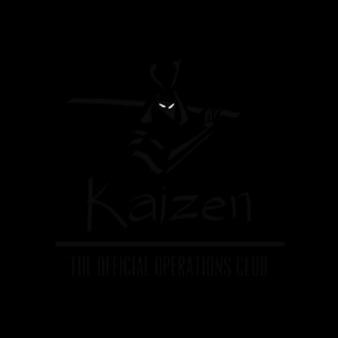CONTENTS
NO.
1
From the Mentor’s Desk 5
2 Operation Scheduling Gantt Chart 7
3 Operational Innovations 11
4 3PL Contract Logistics Operations 13
5
Importance of Information Technology and Business Alignment 15

6
PROJECT MANAGEMENT: an essential management tool in the 21st century 18
7

ROBOTICS REVOLUTION: SOLVING FOOD SUPPLY CHAIN CRISES 21

4| K A I Z E N ’ S O P E R A T I O N S & R E S E A R C H E N T I T Y
S.
TITLE PAGE NO.
From the Mentor’s Desk
In the era of competition, students must be prepared for the ever-changing business environment. Knowledge creation plays an important role to learn to tackle the dynamic nature of business.

I appreciate and congratulate the initiative of club KAIZEN for bridging the gap between the corporate world and academia through LAKSHYA which is an excellent platform where industry practitioners, academicians, and researchers can share their knowledge and experience, acting as a beacon guiding students to reach their goal.
My best wishes to Club KAIZEN in their endeavor of knowledge creation through LAKSHYA.

 Dr. Nishit Kumar Srivastava Mentor, Club Kaizen
Dr. Nishit Kumar Srivastava Mentor, Club Kaizen


5| K A I Z E N ’ S O P E R A T I O N S & R E S E A R C H E N T I T Y



6| K A I Z E N ’ S O P E R A T I O N S & R E S E A R C H E N T I T Y CORPORATE ANGLE
The technique of operations scheduling plays a crucial role in operations management and serves as the foundation for the effectiveness of manufacturing or service organizations. By planning or backward from a specific date, operation scheduling aids in controlling the planning approach. Additionally, schedule production depending on resource capacity and availability to maximize the utilization of supplies. Moreover, this lessens the complexity that may develop at a later stage of the project.




In today’s competitive world, the company that is successful is not only the one that completes the task/orders/services but delivers the quality services on time or before the promise date. Businesses must make sure that every project they work on is done methodically and in accordance with the necessary priorities. Planning a company's production is crucial since it enables them to manufacture items quickly and efficiently, without wasting time, while also saving on inventory inventories, etc. It is very critical for operations of a company to plan and priorities every activity which needs to be performed. Whether it is regarding the project preparation or mid way, or project completion, companies and individuals must prepare a time frame and perform according to deadlines. And this scheduling of operations is effectively undertaken by preparing and evaluating using a Gantt chart.

Using a Gantt chart is one of the most important and well known methods for helping businesses and business professionals schedule and plan their work. A Gantt chart is a tool and example that uses bar charts to help people build project schedules. Gantt chart pictures depict a timeline where a project's components are divided into easier to understand modules and each task is assigned a set amount of time to finish. This breakdown makes it easier to understand how long it will take to complete each task on average, allowing businesses and individuals to priorities their work more effectively and reduce costs by averting delays. It also considers a buffer time frame, which offers each task an additional deadline to be met in case it hasn't already been done.
Gantt chart techniques helps in organizing activities and tasks effectively and efficiently. Gantt charts break down helps in allocating resources like employees for a particular task, amount of money to be spent at each stage etc. Gantt Chart illustrations give representation regarding three parameters

 Ms. Mitali Mittal KPMG, India Digital Consultant
Operation Scheduling – Gantt Chart
Ms. Mitali Mittal KPMG, India Digital Consultant
Operation Scheduling – Gantt Chart
7| K A I Z E N ’ S O P E R A T I O N S & R E S E A R C H E N T I T Y
i.e., time, cost, and scope of the project. Gantt chart is an effective tool to get an idea on elements like time management, finances and tasks which are to be completed.


The value of a Gantt chart may be seen in project planning, as it provides an approximate estimate of the time needed to complete a work and contrasts that with the actual time needed to complete the activity. This makes it easierto comprehendand carryout similarprojects in thefuture,which enables businesses to develop stronger plans.

However, despite its usefulness, Gantt charts are more of a framework for giving a brief understanding about the project schedules and deadlines. Gantt Chart simply gives an approximate time in which each task would be completed. But it is feasible for only understanding small and a smaller number of projects. A Gantt chart for several projects could be deceptive because it is impossible to fully comprehend and evaluate each job and project timeline. Additionally, a Gantt chart simply concentrates on the project's three essential components its duration, scope, and cost. Only time provides a reliable estimate among these, and the other two cannot change significantly as a job is being performed. Additionally, it disregards operational procedures, batch manufacturing, employee management, etc.

8| K A I Z E N ’ S O P E R A T I O N S & R E S E A R C H E N T I T Y
It has been observed that the operation scheduling has a direct effect on the effectiveness of the production function and this relation was explained by Vollman
According to Vollman, “the priority planning and the shop floor control and the scheduling elements ultimately determine the performance of production types.”
If the operation scheduling is carried out in efficient manner, then there occurs a considers improvement in performance and quality of delivery. Also help in achievement go the goals that have been set by the company, Efficient operation scheduling plays a very critical part in the reduction of the production lead times.
About Author:


Mitali Mittal has completed her MBA in Marketing and Finance in 2021 from Delhi School of Business, Delhi. She is currently working as a Digital Consultant in KPMG India.

9| K A I Z E N ’ S O P E R A T I O N S & R E S E A R C H E N T I T Y



10| K A I Z E N ’ S O P E R A T I O N S & R E S E A R C H E N T I T Y EMERGING MANAGERS
Innovations







Operational innovation should not be confused with operational improvement or operational excellence. Those terms refer to achieving high performance via existing modes of operation: ensuring that work is done as it ought to be to reduce errors, costs, and delays but without fundamentally changing how that work gets accomplished. Operational innovation means coming up with entirely new ways of filling orders, developing products, providing customer service, or doing any other activity that an enterprise performs. Executives who comprehend operational innovation's process and the organisational and cultural constraints that prevent it from occurring more frequently can add one of the strongest competitive weapons currently available to their strategic toolbox.
The evolution of markets and customer requirements with highest level of precision, has been achieved created with technology and information systems, a new way of make the operations in the companies, and just the companies with the ability to adapt faster to technological innovations may remain on the market. The last industrial revolution, known as industry 4.0 perceives the operations as a holistic system, its represents a challenge that must be fulfilled and faced in order to achieve stability and permanence in the market, from the point of view of the world economies. Operational innovation should not be confused with operational improvement or operational excellence. Those terms refer to achieving high performance via existing modes of operation: ensuring that work is done as it ought to be to reduce errors, costs, and delays but without fundamentally changing how that work gets accomplished. Operational innovation means coming up with entirely new ways of filling orders, developing products, providing customer service, or doing any other activity that an enterprise performs.
Mr. Akash Kumar MBA, 2021-2023
School of Management, Delhi Technological University
11| K A I Z E N ’ S O P E R A T I O N S & R E S E A R C H E N T I T Y
Delhi
Operational
The evolution of markets and customer requirements with highest level of precision, has been achieved created with technology and information systems, a new way of make the operations in the companies, and just the companies with the ability to adapt faster to technological innovations may remain on the market. The incredibly easy solution to Progressive's success is that it outperformed its rivals. By undercutting its competitors' costs and providing superior service, it merely stole their clientele. The creation and adoption of new methods of conducting work was what allowed Progressive to offer better pricing and services.
The last industrial revolution, known as industry 4.0 perceives the operations as a holistic system, its represents a challenge that must be fulfilled and faced in order to achieve stability and permanence in the market, from the point of view of the world economies. In the organizational and business area all the operations must be linked to computer systems and management of information in the network, which causes greater efficiency in the flow. With this new perception of industry and the business, it involves different analytical tools that aim at bigger efficiency in the service to the consumers, resulting in a greater competitiveness in the market and making the differentiaton.


Industry 4.0 is one of the primary paradigms of the current industrial context. Despite the widespread research on this topic, an analysis of its key technologies' impact on company performance and resilience is not available. Hence, this work proposes a conceptual model for investigating the influences among Industry 4.0 key technologies (IT related and Operations related technologies), organizational resilience (in terms of internal and external) and performances in Italian companies. We distinguished company performance, referring to companies' results in the past, from organizational resilience, which investigates future survival chances. Using structural equation modelling, a second order construct has been used to test the hypothesized relationships. The results show that the implementation level of Industry 4.0 IT related key technologies positively impacts organizational resilience and perceived performance. These results can assist company managers and decision makers in increasing organizational resilience by effectively implementing Industry 4.0 technologies. In the organizational and business area all the operations must be linked to computer systems and management of information in the network, which causes greater efficiency in the flow. With this new perception of industry and the business, it involves different analytical tools that aim at bigger efficiency in the service to the consumers, resulting in a greater competitiveness in the market and making the differentiaton.

12| K A I Z E N ’ S O P E R A T I O N S & R E S E A R C H E N T I T Y
While Freight Forwarding is an important function of 3PL Service providers to facilitate the Supply Chain, another equally important function managed by 3PL Logistics Companies is Contract Logistics.
3PL companies offer services for building up consolidation centres, distribution centres, warehouses, and inventory management services under the broad heading of contract logistics. In comparison to the rest of the globe, Europe's transportation and storage networks are highly developed in terms of supply chain capabilities. America has recently achieved these skills as well. Typically, storage facilities are constructed as real estate and rented out. Distribution Centres or Warehousing Parks are built with a complete infrastructure for yard management, truck parking, security systems, etc.
All weather docks, dock levellers, and dock platforms are included in warehousing buildings with sizes ranging from 1000 square metres to several hundred square metres to enable continuous loading andunloadingoperations andquickvehicleturnaround. Asafull standalone facility, these facilities also feature office space and other amenities. In some circumstances, 3PL companies invest in developing their facilities in strategic positions near large markets, near customer facilities, or in critical locations within the transportation network.


Utilizing 3PL Warehousing, inventories of both raw materials and completed items, as well as any necessary spare parts, consumables, and marketing materials, are managed. A 3PL may set up an entirely dedicated facility for a client's unique requirements, provide dedicated storage space and services in a shared facility, or give pallet by pallet storage on a rental basis, depending on the demand and size of operations. Depending on the specific requirements of the logistics plan, all of these options are utilised.
Typically, warehouses are made up of vertical racks with five to ten levels, with a carrying capacityofonetonneperpalletposition.Rackingdesignscanrangefrom palletrackingto block stack, deck, shelves, bins, etc. depending on the amount of storage required. Hand pallet jacks, trolleys, battery operated forklifts, and several types of reach trucks utilised in racks are a few examples of the material handling equipment employed.





13| K A I Z E N ’ S O P E R A T I O N S & R E S E A R C H E N T I T Y
Mr. Ashutosh Goel MBA, 2021-2023 IBS Hyderabad 3PL Contract Logistics Operations
Receiving Process, which involves unloading, de-skidding, inspection, in awarding, and put away, makes up the entirety of warehouse operations. Delivery or shipment includes receiving the shipping order and invoice or sales documentation from the customer, selecting the materials, consolidating them, packing them, labelling them, assembling the outgoing paperwork, and shipping them by loading them into containers. Along with these duties, the warehousealsoperforms inventorymanagementtasks,suchasmaintainingstoragespaces,bulk and loose inventory, and conducting inventory counts to assure inventory and stocktake accuracy.


Systems and paperwork that control operations and inventory are crucial to the success of the entire warehouse operation. WMS, or warehouse management system, serves as the foundation in warehouses. The system regulates and generates warehousing operations for both inbound and outbound transactions, as well as storing inventory at a detailed level and managing inventories. It also manages inbound transactions, location management, and outgoing transactions. Every principal employer needs the assistance of a reliable 3PL because their entire inventory, which is worth a significant amount, is in the care of a different party. Activities for inventory management are essential to all operations. Therefore, before making a decision to outsource these tasks, every SCM expert must comprehend the subtleties of 3PL Contract Logistics operations.
In order to enable a higher standard of service and lean logistics operations, businesses execute full logistics outsourcing at any part of your supply chain, from procurement, manufacture, sales and distribution, to after service. By integrating our freight forwarding services with our local logistics hubs and transportation networks in each country, businesses may also build global 3PL models to assist your company's growth. Company use cutting edge information technology to improve visibility of your order reception, inventory levels, and other factors while collaborating with you to improve the quality and efficiency of logistical operations. Companies, a pioneer in the 3PL sector, are dedicated to offering you the best logistical solutions possible while utilising our depth of knowledge, consulting skills, extensive infrastructure, and cutting edge technology

14| K A I Z E N ’ S O P E R A T I O N S & R E S E A R C H E N T I T Y
Anushka Agarwal

Importance of Information Technology and Business Alignment


IT business alignment is the operationalization of IT strategies in accordance with organisational goals and objectives, as well as the dynamic actualization of those goals and objectives. The organisational goals are typically stated in terms of increased financial performance and continued market competitiveness. Organizations might declare, for instance, that they want to use IT to boost sales and revenues by 20%, cut costs by 10%, boost profits by 15%, and attain profitability. Organizations may also want to declare their market-based goals, such as increasing market share, where they expect to use IT to expand their reach into emerging markets and existing markets. The organisational capability to use the former for the latter's success is hence IT business alignment. This means that for a company to assert that its IT and business plans are compatible, there must be little to no conflict between the IT department's decision makers and those in the corporate/business departments.



The organisational imperative to realise a favourable relationship between the usage of information technologies and stated and recognised measures of financial and business success is known as IT business alignment. The reality is that there are substantial gaps between what the business needs and what the IT systems can provide, making IT business alignment more difficult to achieve in practise. This is mostly caused by a lack of comprehension of how IT systems operate and provide value, as well as cultural factors, a lack of coordination and cooperation between the business and IT departments, and other factors. It's a common concern among business and corporate executives that IT staff members use obscure language. However, the IT staff cites how business and corporate departments demand unrealistically high levels of performance from IT systems, despite the fact that these systems typically achieve more or less what are stated in the reasonable criteria. Many CIOs also bemoan the fact that CEOs, CFOs, and COOs frequently view them as magicians capable of lifting their companies to new heights. They are also irritated since, in reality, IT systems and their operationalization follow the mutually agreed upon specifications rather than appearing out of thin air.

15| K A I Z E N ’ S O P E R A T I O N S & R E S E A R C H E N T I T Y
Ms.
MBA, 2021-2023 IBS Hyderabad
The Six Steps to Actualize IT Business Alignment
Since there are significant benefits of aligning IT and business strategies in terms of the significant value that can be added to the organisations provided, they leverage IT strategically, efficiently, and efficaciously, ITbusiness alignmentisfrequentlyreferredtoasthe"Holy Grail"thattheorganisations must strive for. Organizations can do this by adopting six practises or traits that would guarantee IT and business are complementary. Recognizing and realising that IT may be used as a transformative instrument in enterprises is the first step. To accomplish this, businesses must recognise the potential ofITto integratevariousanddiscretebusiness functions andprocessesinto acomprehensivebusiness stream, as can be realised when the entire sales and marketing cycle starting with cold calling customersandendingwiththecontractbiddingandfinalization isautomatedinasinglevaluechain. This would eliminateredundancies,reduceduplication,andresult in amoreefficientuseofresources. Following on from the previous phase, the second requires businesses to use IT to target both internal and external clients.

The third consideration has to do with how the IT and business employees must "speak to one other" in a way that is understandable to both parties. We have already discussed the glaring communication gaps that exist between these employees. The organisation must therefore rotate workers between these roles in order for them to gain practical knowledge about and firsthand experience with being on theopposingsidein orderto actually implement tighter ITbusiness alignment.Tofill thepositions of CIOs and, to some extent, in the corporate and business executive duties, many firms prefer IT professionals who have a business management specialisation as well as business management graduates who have a specialisation in IT.
The second consideration has to do with clearly outlining the IT department's aims and objectives. This involves management by objectives, in which the IT department is assigned the SMART (Specific, Measurable, Achievable, Realistic, and Time Bound) model expressed financial, operational, and strategic objectives. The fifth, and arguably most crucial, step in achieving better IT business alignment is to create Returns on Investment (ROI) from the IT systems that are failsafe, almost correct, reliable, and measurable. Organizations frequently struggle to develop and define the ROI from their IT investments, which leaves them unsure of whether their time and effort was worthwhile. This is the rationale behind why many businesses express ROI in terms of each dollar invested on IT systems.

The sixth component is to compile all of these components into a written document, preferably one that lists the IT and business strategy and explains how they should interact. At the risk of sounding repetitive, we want to emphasise that without a requirements and specifications document, which is written by business departments in business terminology and by higher level IT staff for use by programmers in technical terminology, the resulting IT systems typically look disorganised and like a waste of time. The CEO or COO and the CIO frequently meet to develop the business needs, which are then approved by both parties. The IT team then creates the technical specifications, which are

16| K A I Z E N ’ S O P E R A T I O N S & R E S E A R C H E N T I T Y
subsequently approved by the CIO. The existence of a "single source of truth," which is the artefact explaining the IT business alignment and how the organisation desires to actualize the same, is another crucial requirement in this situation.

IT Business Alignment, Governance, and Transformation

The generation of value at each stage of the value chain of the businesses' internal and external activities is the secret to effective IT business alignment. Both process improvements and technology are used to achieve this value. We can think of IT as the enabler and transformer of organisational processes that result in higher productivity and more value at each chain of the internal and external value chain for the businesses since we are talking about the function of IT in creating value. Additionally, a lot of firms use IT to supply real time information and automate, integrate, assimilate, and integrateit into business operations. Utilizingthesynergies betweentheseoperations, whichwere previously inefficient, is the business driver in these situations. Additionally, businesses use IT to expand their operations, a process known as actualizing the advantages of economies of scale. Aside from that, IT is utilised to enter additional geographical and virtual market segments because automating processes and using IT frequently gives users a seamless experience no matter where they are or when they are using it.
The IT and business functions must collaborate effectively in order for all of these things to happen. IT needs to develop into a transformational instrument and a source of long term competitive advantage. For instance, would you choose a rival bank with limited banking hours that requires you to visit the branch for even little transactions if your bank has 24/7 virtual banking as well as a wide network of ATMs? This is the power of IT, which can only be realised if business and IT initiatives work in tandem and complement one another.
Conclusion
Any new effort frequently encounters ego confrontations, power struggles, opposition from vested interests, and pushback from established power centres in real world organisations. Given that IT is viewed as a constructive agent for change, it is in the organization's best interests to avoid these sources of friction and instead match their IT and business plans for the company's ongoing success.

17| K A I Z E N ’ S O P E R A T I O N S & R E S E A R C H E N T I T Y
A project is a temporary undertaking or venture that spans organizational and functional boundaries and is implemented within cost, time, and quality constraints while respecting the intended goals. It is also described as a set of unique and interrelated activities that share the same purpose and should be performed according to a single specification. A project should therefore be distinguished from a process as an activity that determines how each function works on a case by case basis. Contemporary organizations try to achieve their overall business goals by aligning them with specific projects. Project management requires meticulous planning and preparation. Managers must be able to assess the requirements and limitations of particular efforts.




Companies must have agile, flexible, and reliable work processes and structures. The 21st century has created a decentralized organizational model. It seeks to create scalable and automated business processes that enable management to take advantage of new opportunities. Several tools and methodologies have been designed to produce superior results. Project management helps organizations achieve efficiency and effectiveness. This process must be conducted reliably and consistently, which can only be achieved through rational and realistic planning. In managing the project, adequate preparation and using research resources to draw accurate conclusions are crucial to success. This article will seek to explore the design and planning phases of a project. Project management is the development, mobilization, and allocation of resources to achieve business goals. Projects are defined as initiatives with a specific purpose and time frame. The whole process follows a systematic and methodical approach. Projects are initiated to obtain tangible and intangible benefits for the business organization. A project is generally a temporary commitment that has been recognized and defined goals.
Globalization and the Internet are the driving forces that have impacted the business environment in the 21st century. The Internet has become a powerful means of conducting commercial transactions. Large organizations have created e commerce websites to increase their sales and profits. Flipkart



Mr. Nitesh Kumar Gautam MBA, 2020 22 IBS Hyderabad
PROJECT MANAGEMENT: an essential management tool in the 21st century
18| K A I Z E N ’ S O P E R A T I O N S & R E S E A R C H E N T I T Y
has become a brand name in the Indian e-commerce market. The organization sought to use its brand image, equity, loyal customer base, and innovative business approach to enter the online shopping market. The organization's strategic goal is to create a dedicated online platform for customers so that the customers will have 24/7 access to the organization's products. The organization will also significantly reduce operating costs, and it can target regional and international audiences through online portals.


Sponsor coordination and integration are essential parts of the entire process. End users are regularly consulted for valuable feedback and advice. As project managers, it is our duty to ensure that the design and planning phases are executed intelligently. The first responsibility is the descriptive and scope analysis of the project. This involves creating specifications that minimize the presence of flaws, weaknesses, and problems. Customer requirements and requirements have been translated into achievable goals. Operational processes have been evaluated in the context of the business environment. A conceptual framework has been developed to provide clarity and guidance. The humanresources andtechnologyrequiredfortheprojectwerecarefullyevaluated.Abudgetiscreated through due diligence and financial evaluation. Project costs were determined to create a workable budget. Stakeholder interests and requirements were taken into account in this step. A comprehensive document must be created covering costs, responsibilities, goals, and schedules. The planning phase of a project involves a number of activities and responsibilities. He is looking to create a workable plan based on the requirements of the organization, business, and workforce. The functionality of the website has been determined by an intelligent approach. Quality standards have been designed to ensure outstanding results. Performance monitoring and evaluation systems have been designed to minimize or minimize problems. Specific control systems have been designed to track the progress of teams. Team leaders were selected to provide regular updates on project implementation.

19| K A I Z E N ’ S O P E R A T I O N S & R E S E A R C H E N T I T Y
A variety of factors are involved in the intricate and complex discipline of project management. It involves classifying, scheduling, and allocating resources in order to carry out projects. A project is an endeavor with a clear goal and deadline. Numerous phases are involved in project management. The process of establishing and recognizing objectives is part of project conception. It aims to create a strategy that will be successful and efficient in achieving corporate objectives. The creation of the project aids management in planning an effective strategy. The project planning phase is another crucial one. A thoroughandworkable implementation strategyis createdduring this phase.This stage aids in developing a conceptual framework that directs managers in achieving organizational objectives. Adopting a defined set of practices is critical to ensuring that your project achieves its goals. This is achieved by applying knowledge, methods, and techniques to project stages and underlying activities and is called project management. There are extensive descriptions of the objectives of project management. Still, these are typically aimed at developing and implementing project procedures, ensuring transparent communication within project teams, and delivering projects that meet expectations. Project management is procedural but requires customization depending on project size, team composition, and specifications.




20| K A I Z E N ’ S O P E R A T I O N S & R E S E A R C H E N T I T Y
The global food supply chain is dealing with major challenges. Widespread labor shortages, the war in Ukraine leading to rising energy prices and grain shortages, and rising levels of food waste have raised concerns about food price inflation and possible shortages.
As a result, there is a surge in demand for robotics as a solution to many of the problems plaguing the food supply chain. The industry has been investigating automation options for years.But business solutions thatwereoncejust a considerationarenowmoreurgent. Concerns about the need to maintain food supply chains have led many companies in this industry to increase investment in automation and robotics technology.
Businesses and consumers around the world are being affected by supply chain disruptions. A typical food supply chain consists of about six stages.
• Procurement of Raw Materials and Ingredients



• Production
• Processing and Packaging

• Storage
• Wholesale Distribution

• Retail Distribution to Consumers


If the stages listed above cause a bottleneck situation for the consumer, the entire supply chain will be affected. Some of the ongoing issues facing the food supply chain are:
Lack of traceability When companies cannot track food products at every stage of the supply chain, it can lead to inefficiency and mistrust.
Rising Supply Chain Costs One of the biggest challenges faced in the supply chain is rising costs due to rising fuel prices and labor issues.
Poor Communication Poor communication by supply chain partners can lead to excessive waste, inefficiency and errors.
21| K A I Z E N ’ S O P E R A T I O N S & R E S E A R C H E N T I T Y
Ms. Kashish Tyagi MBA, 2021 2023 IBS Hyderabad ROBOTICS REVOLUTION: SOLVING FOOD SUPPLY CHAIN CRISES
Robots are an important part of solving problems that continue to plague the food supply chain. The food industry has been relatively slow to adopt robots compared to other industries. But in recent years, that has begun to change. As robotics has advanced, it requires less supervision and time. In fact, many robots work alongside humans. Some robots perform tasks that humans can't, shouldn't, or maybe can't do. After all, pain is a great motivator. The way robotics is modifying the food supply chain is listed below.
Robotics in Farming
Food pathways primarily originate from agriculture. Precision agriculture, which uses key interventions to improve and optimize productivity, is expected to be worth about $8.5 billion this year and $15.6 billion by 2030. Today, farmers use robotic solutions for everything from planting to sorting and identifying seedlings. They also invest in automatic harvesters, weeders and tractors. Autonomous ground vehicles and drones are also being used to analyze and monitor crops. When working with farm animals, farmers use robots to feed, milk, sort and clean.
Robotics in Food Processing and Manufacturing

Once materials leave the farm, they are sent to a processing or manufacturing process. Robotic solutions are used in his two main steps in food production.

Primary processing: Raw food is washed, sorted, mixed and transported. Robotic applications include slaughtering and sorting vegetables and fruits.
Secondary Processing: Combining ingredients to create new food products for packaging, cooking and baking. Robotic applications include product sorting, reject removal, and shuffling.

Many of these processes are repetitive and assembly line like, making them ideal candidates for robotics. In the past, many food processors focused on secondary processing, but primary processing robots are becoming more common.
Robotics in Food Packaging and Storage
Food packaging and storage are two areas of the food supply chain where robotics will have a major impact. This is because human handling of these functions can be incredibly repetitive and inefficient.
During packaging, robots can pick and place items into individual packages, place tubes or wrappers of items into larger product cartons, and aggregate food items onto pallets for shipping.
During storage, there are some possibilities for better robotics. Most warehouses already have a warehouse management system and a WMS. These companies can improve efficiency and transparency using automated warehouse and retrieval systems, air storage drones, automated picking and packaging using robots and RFID tags, and more.
22| K A I Z E N ’ S O P E R A T I O N S & R E S E A R C H E N T I T Y
Robotics in Food Transportation

Food transportation is costly and inefficient. We won't see robots operating semi trucks or freighters anytime soon, but robots will be used at this stage of the process. Some industry members have adopted the Last Mile robot as an effective food delivery source. For example, Nuro is currently running pilot programs with Kroger, 7 Eleven, Domino's, and Chipotle.
So, what about delivering food to the customer's table? These functions are now handled by robots. An analysis by McKinsey and Company concluded that nearly three quarters of hospitality tasks can be automated. You will increasingly see robots performing some of these functions in the local restaurants.
Since 2020, nearly every aspect of modern life has been disrupted, and there are constant challenges in nearly every industry. Food supply chain has to function efficiently and urgently because everyone needs to eat.

Fortunately, companies are using various robotic solutions to improve efficiency, increase transparency and even reduce costs across their supply chains. In the future, it will help supply chain participants improve overall outcomes and give everyone a little more stability they need to survive.
For example, Tyson Foods, which produces about 20% of the chicken, pork and beef produced in the United States, has invested more than $500 million in automation advancements in the last three years alone.

23| K A I Z E N ’ S O P E R A T I O N S & R E S E A R C H E N T I T Y
ABOUT US
The word “Kaizen”, where “Kai” = change, “Zen” = good, signifies change for the better. In its birthplace Japan, the word Kaizen is imbibed as a process that many small continuous changes in systems and policies bring effective results than few major changes. This methodology applies to every department across different sectors.


Kaizen TheOfficialOperationsClubofIBSHyderabadhasalwaysbeenaspiring“ConstantChange ad Evolvement”. We, as an organization work to inspire and aspire to the student community for the betterment of the future.
KORE Kaizen’s Operations and Research Entity, one of our primary wings provide the students with a platform to improve and hone their technical competencies to meet the changing demands of the organizations. KORE’s sphere of influence includes Case Based Research, Consultancy, Live Projects, and Workshops.LAKSHYA,aninitiativeofKOREfocuses on improvingthereader's knowledgeabout Operations Management by providing insights in the form of articles on various operation techniques followed by different companies and also updating the emerging trends in the communities.
ANAMIKA BHARDWAJ

EDITOR IN CHIEF KORE
Club Kaizen IBS Hyderabad Batch 2021-23

24| K A I Z E N ’ S O P E R A T I O N S & R E S E A R C H E N T I T Y
LAKSHYA is an academic print and is not for any commercial sale. Reliability and Responsibility, for sources of data for the article vests with the respective authors. Please feel free to drop in your suggestions at kaizenclub.ibs@gmail.com
KORE: Kaizen’s Operations & Research Entity. Kaizen The Official Operations Club of IBS Hyderabad



All Rights Reserved
Designed by


25| K A I Z E N ’ S O P E R A T I O N S & R E S E A R C H E N T I T Y

